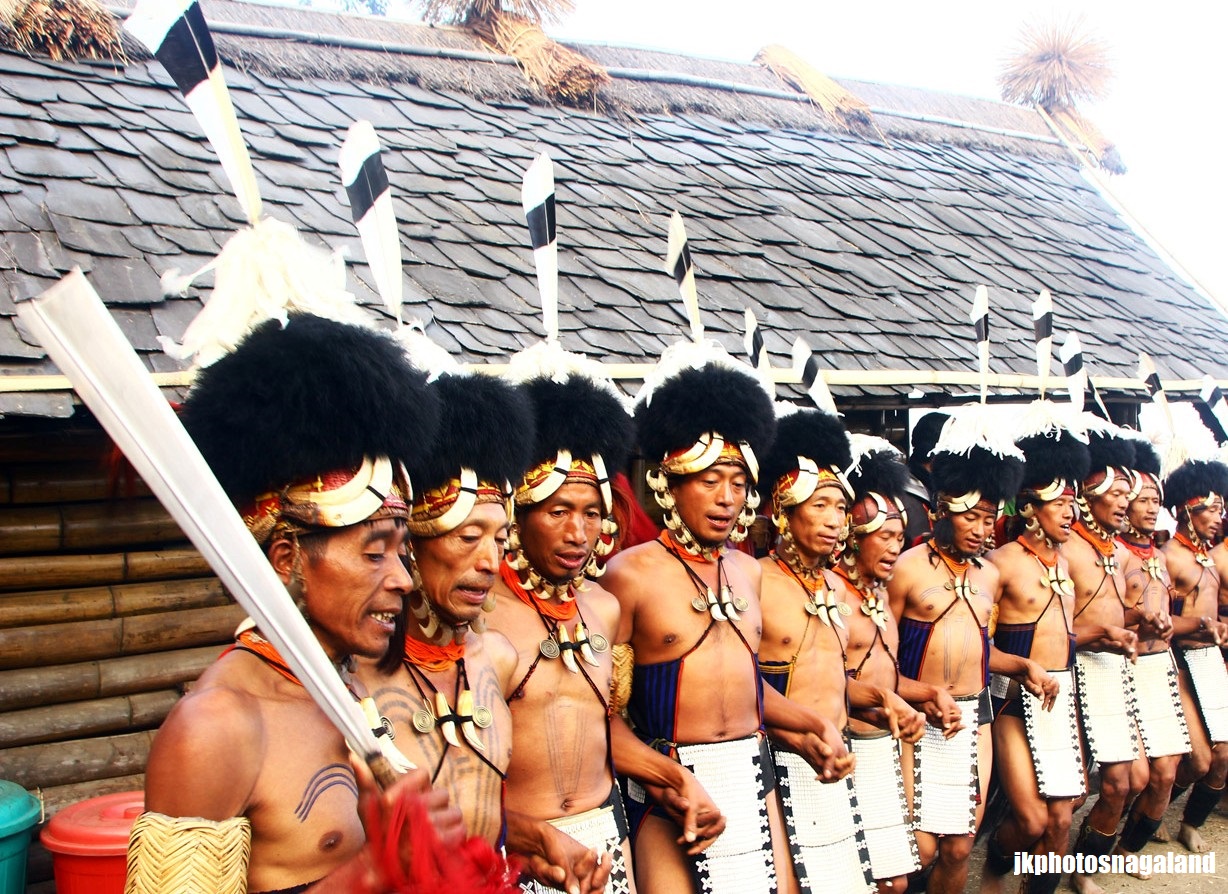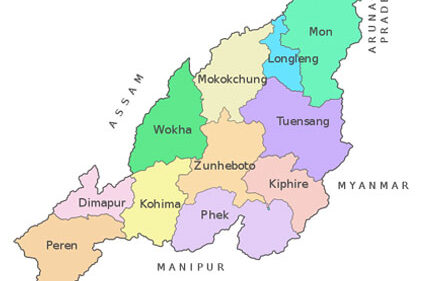Nagaland which is also known as ‘The Land of Festivals‘ is a small hilly state in the North Eastern part of India. It is home to various ethnic Naga tribes. There are officially 16 recognized Naga tribes of Nagaland along with other Scheuled Tribes in Nagaland. Though the Naga tribes are all united under the umbrella term ‘Naga’, each tribe has their own unique culture, clothing, food habits, festivals, dance forms, language etc.
Nagas celebrate festivals all throughout the year. Music and dance play a huge part in Naga culture. There is no traditional event which does not feature a traditional folk song or dance. In this post, we shall see the names of traditional folk dances of Nagas of Nagaland.
Traditional Folk Dances of Nagaland

Changsang (Chang)
- Changsang dance is a traditional folk dance performed by the Chang Naga Tribe of Nagaland during Naknyulüm festival in the month of July.
- Changsang dance is performed in praise of the birth-place of mankind and the earth. Prayers run neck to neck along with the dance during the festival to which the dance is associated in order to propitiate the sky God.
- Colorful outfits accompanied by matching songs are performed during the period of Puanglem/Nknyulum festival by the Chang Nagas.
Chang Lo / Sua Lua (Chang)
- The Chang Lo Dance also known as ‘Sua Lua‘ is a traditional folk dance of the Chang Naga tribe of Nagaland.
- It isperformed to celebrate the victory over enemies in the earlier times.
Monyu Asho (Phom )
- Monyu Asho dance is a traditional folk dance performed by the Phom Nagas during the festival Phom Monyu festival which is the biggest festival of the Phom Naga tribe. It is celebrated in the month of April.
- The Monyu festival is a post sowing festival to invoke divine blessings. It marks the end of the winter and beginning of summer. It is also a time of prayer and dedication for the seed sown and are already sprouting.
Melo Phita (Angami)
- Melo Phita dance is a traditional folk dance performed by the Angami Nagas during the Sekrenyi festival in the month of February.
- Sekrenyi festival is a purification festival. It is observed for ten days from the 25th day of the Angami calendar month of “Kezei” (usually corresponding to 25 February in the Gregorian calendar). It is a “purification festival” held to wash off all past sins. The objective of the festival is to renew and “make holy” by cleansing the “body and the soul”, and to bring forth unity. It also marks initiation of young people to adulthood.
Udoho (Angami)
- Udoho dance is a traditional war dance of Angami Naga tribe.
- The literal meaning of Udoho is holding spear and shouting on enemy. It depicts the position of warrior in the village.
Angushu Kighilhe (Sumi )
- Angushu Kighilhe dance is a traditional war dance performed by the menfolk of Sumi tribe.
Rukhyo Sharu (Lotha )
- ‘Rukhyo Sharu’ dance is a form of traditional folk dance performed by the Lotha Naga tribe.
- The word ‘ Rukhyo Sharu’ literally means ‘victory dance’. It was performed during the head hunting days to celebrate victory over the enemy.
Langnyu-Khiamtsangshe (Khiamniungan)
- ‘Langnyu-Khiamtsangshe’ dance is a traditional folk dance performed by the Khiamniungan Naga tribe of Nagaland during two of their most important festivals i.e. Miu and Tsokum, which are co-related to each other.

Akok-Khi (Sangtam)
- Akok-Khi is a dance form performed by the Sangtam tribe during the Mongmong festival.
Khupielilie (Pochury)
- Khupielilie dance is a traditional folk dance performed by womenfolk of the Pochury Naga Tribe of Nagaland.
- This dance is an integral part of the Nazu festival of the Pochury tribe in the month of February every year.
- Khupielilie is the dance where only womenfolk participate.
Kukuyipheto(Chakesang )
- Kukuyipheto dance is a traditional folk dance performed by Chakesang Nagas.
- It is an excellent choreography as the dance consist of fast and complicated footwork.
- This dance is performed during a grand feast known as ‘Feast of Merit’, and is carried out by all the able-bodied men in full traditional attire.
Kulu-Tsen (Yimkhiung)
- The ‘Kulu-Tsen‘ is the name of a traditional Naga folk dance of the Yimkhiung tribe.
- Kulu’ means head, and ‘Tsen’ means dance.
- It is a dance associated with head-hunting.
Nokinketer Tsungsang (Ao)
- Nokinteker Tsungsang dance is a Naga traditional dance form of the Ao Naga tribe.
- ‘Nokinteker ‘ literally means ‘war hero’.
Butterfly Dance (Zeliangrong)
- Butterfly dance is associated with the Zeliangrong tribe.
Baimaijai / Plate Dance (Kachari)
- Baimaijai dance is a traditional folk dance of the Dimasa. The dance is performed by young girls or women with Plate or Dish and they perform the dance with two plates in both hands. This dance has a distinctly unique feature. In the past, during the reign of the Dimasa kingdom, the king had come out victorious in the war and offered victory at the Palace through delight.
PS: You can help us improve this article by sending us details of other Naga traditional dances to info@nagalandgk.com .Kindly include the name, tribe and a brief information about the dance.



Leave a Comment (FB)